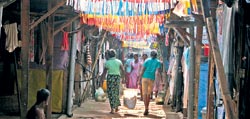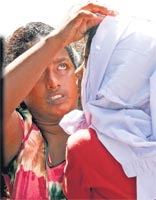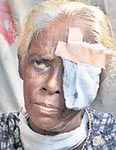
House or no house they have to goKumudini Hettiarachchi reports on the plight of tsunami survivors facing eviction from shelters on Poson Poya
For most, the tsunami which hit Sri Lanka in December 2004 with the ferocity of a predator is now only a distant memory. But for many thousands, those terrible waves are as real as if they shattered their lives yesterday. These thousands of men, women and children are still languishing in temporary shelters, homeless and amidst the filth and muck generated by long-term stays in overcrowded locations.
To add to their woes, now hangs a deadline: whether you have a house or not, depart from the camp on May 31, Poson poya. A visit to the Podu Jaya Kandawura in Angulana, Moratuwa, nearly two and a half years after the tsunami is like a walk into the very depths of hell. Located in the playground of a school, the first sight of the camp is rows and rows of box-board rooms, worse than some of the current line-rooms on estates, with a knot of women seated in front. As they pull out a plastic chair from a bare room, sans furniture but a heap of unwashed clothes and a few empty pots and pans, the laments pour out, some gesticulating in anger, others near tears of despair. “We will leave this kandawura right now if we have a place to go to,” is the chorus, as swarms of flies settle on everything visible, including faces, hands and hair. A mother carrying a child stops by on her way down the narrow path between two box-board line-rooms. The child, with the face and head wrapped in a dirty white cloth, looks ill. “Kammul gaya,” says the mother, explaining that it is mumps, as the little one’s head lolls on to her shoulder.
The complaints are many and varied and amidst the babble of voices, The Sunday Times understands that the 172 families living here – a microcosm representing the problem of the displaced people across the coastal regions of Sri Lanka – fall into several categories.
“The authorities are telling me to remove this temporary room and build my home,” says Kamani Niroshika, 27, pointing at her tiny room and explaining that the walls are made of box-board which cannot be used. “Only the asbestos roof sheet can be taken.” Niroshika has got Rs. 250,000, channelled through the Moratuwa Divisional Secretariat, and bought eight perches in Kalutara to build herself and her husband a little home. “We have handed over the documents to get the balance Rs. 250,000, in instalments, but we are told there is no money,” she grumbles. M. Selvin Nimalsiri Fernando, 54, sits in front of his room, swatting flies and chewing betel. He doesn’t work as a carpenter because of this overwhelming problem of having no place of their own. A squatter on the beach for 14 years, with his wife and three children when the tsunami struck, they lost everything they had. Twenty-eight families along with Fernando have bought six perches each at one place in Panadura but cannot get their house plans passed by the local authority because the land owner has not paid up the rates for his property. “Saree hari ellagena yanawa, salli pass wunoth geyak hada ganna,” says Selvin’s wife Kusumalatha, explaining that if the money for the construction of their homes is passed they would leave the camp and hang sarees to make a room on the land they have got, as Gamini Nandasiri nods vigorously in agreement.
Gamini a “diametic and pressure” case (diabetic and a sufferer of hypertension) calls out his ailing wife, who has a huge cancerous tumour on her face, to indicate his pathetic situation. “She is in and out of hospital,” he says sadly. “We were told to look for a land, but now we are told that we won’t get the money,” says 21-year-old Lakshani Hemanthi with an infant hanging on to an emaciated breast. “This child was born when I was in the camp,” cries Lakshani who has another four-year-old in pre-school. Why are people like Lakshani and her husband, a lottery seller not entitled to the Rs. 500,000? “They say it is because we were living on rent,” she says, mumbling humbly that their breakfast was a little rice, dhal and batto (small river fish) left over from the previous night. “We went to a meeting at Araliya Mandiraya (Temple Trees) and some of us were given a voucher saying that we are entitled to the money.” This is while others who have been in rented homes have not been issued the voucher. In a few other cases, though the affected people have bought six perches in Bandaragama, they are unable to build their homes because the Pradeshiya Sabha has stipulated that they need 10 perches to get the housing plan passed, it is understood. When asked whether no official advised the tsunami-affected on the different requirements they may have to comply with before land sales were finalized, an officer of the Moratuwa Divisional Secretariat was of the view that they didn’t have the capacity to do so, giving the impression, obviously reflected all over the country, that there has been no cohesive system, only ad hoc decisions. Confounding the confusion are serious allegations by some families of harassment by the Grama Sevakas with whom they deal with. A case in point is Nimalin Peris and son Dilip Rohana. “I lived with my mother on the beach and our home had all the documents. My brother was living next door. They’ve passed the money to my brother but are refusing to give my mother her due,” says Rohana. With a recent change in Grama Sevakas, these victims are also being shunted here and there – on the excuse that if a case was dealt with by the earlier GS then they need to go to that officer. Where does one begin to unravel this complex issue, with problems within problems? The bottom line, of course, is that these problems are increasing and prolonging the suffering of the thousands of men, women and children living in these temporary shelters. In the living hell in Angulana, the toilets are overflowing. The garbage is piled high. A long queue forms everyday for a few pots of water from the single pipe servicing the shelter. Hetata wediya ada yanna kemathie – we would like to leave right now today and not tomorrow, is the consensus among the “inmates” of this shelter………with some even considering suicide or violence in desperation. |
|| Front
Page | News | Editorial | Columns | Sports | Plus | Financial
Times | International | Mirror | TV
Times | Funday
Times || |
| |
Copyright
2007 Wijeya
Newspapers Ltd.Colombo. Sri Lanka. |


